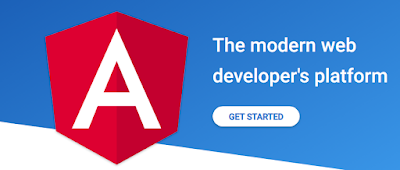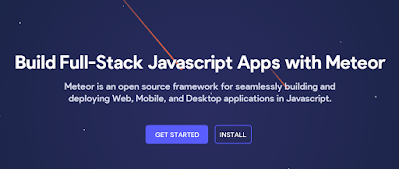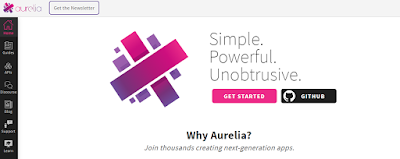Most programmers find it difficult to decide which structure to learn and use. If you have been using JavaScript (along with jQuery) to support HTML, you know that it takes a lot of effort and code complexity to develop and maintain a great application. JavaScript Frameworks help you quickly build interactive web applications (which include single- and multi-page applications).
Top 10 JavaScript frameworks list
1. Angular.js
Angular.JS as it is the most commonly used JavaScript framework in the JavaScript community. Launched in 2009, it was developed by Google (which is convincing enough to use it), and is an open source project, which means that you can read, edit and modify the original source code for your specific needs without give money to your developers
- Angular.js is one of the most powerful, efficient and open source JavaScript frameworks.
- Google manages this structure and executes it for use in the development of single page applications (SPA).
- Angular is a platform for building mobile and desktop web applications.
- Extends the HTML to the application and interprets the attributes to make data connections.
2. Feedback.js
- React Framework created by Facebook. It became popular and famous in a short time.
- It is used to create and manage dynamic web page user interfaces.
- In addition, it uses a virtual DOM, so your connection to any application is simpler and more direct.
3. Vue.js
Its open source JavaScript framework was launched in 2014, supporting an extremely simple API for the development of reactive components for modern web interfaces. Its design emphasized ease of use. Like Ember, it uses the Model-view-viewmodel (MVVM) design paradigm that helps to simplify design.
- Vue.js was developed in 2014 by Ivan Yu, a former Google engineer.
- Vue.js is a progressive JavaScript framework that was unknown until 2018 in the JS universe.
- It is the newest in JS library, but it has become more popular in the last 2 years, gaining immense popularity in the field of web applications.
- The main advantage of this structure is used for front-end protection. In addition, Vue is also fully capable of providing innovative single page applications when used in conjunction with modern tools and support libraries.
4. Meteor.js
With a variety of resources for back-end, front-end development and database management, Meteor is ranked as the most popular JavaScript frameworks. Since its inception in 2012, this structure has grown in terms of performance, user interface design and so on. Meteor.JS covers all phases of the software development cycle and takes care of obscure processes such as linking, file concatenation and others. It is currently used in real-time application development for companies like Mazda, IKEA, Honeywell and many others.
- Meteor, or Meteor, is a free, open source isomorphic JavaScript web framework called Node.js Written to be used by.
- Meteor allows for rapid prototyping and creates cross-platforms that include Android, iOS, web code
- It integrates with MongoDB and uses distributed data protocols and sample publication / subscription, which mechanically propagates information to customers for changes, without requiring the developer to write any synchronization code.
5. Backbone.js
This framework can be easily integrated into any third party template engine, however, by default it supports Underscore templates, which is the only dependency (along with jQuery), so it is known for its extremely light nature. It has a JSON RESTful interface with support for the MVC design paradigm (Model - view - controller) (which updates the front-end and the back-end automatically).
- Backbone.js is one of the most popular JavaScript frameworks in 2020.
- This structure is easy to learn and understand for developers.
- One of the main objectives of this structure is to be able to create a single page application. It is a front-end development framework launched in 2010.
- The development of this framework includes the idea that all resources on the server side must follow the flow through an API, which can help in reaching complex functionalities by writing very little code.
6. Ember.js
Ember was launched in 2011 as an open source project by Yehuda Katz. It has a huge active online community, so the moment you run into a problem, you can ask them. It uses many common JavaScript languages and best practices to ensure that developers get the best out of it right away.
7. Aurelia.js
As a self-proclaimed web development framework, Aurelia makes the website development process more creative. Designed with the latest JS, ES6 standard, Aurelia has the ability to work on all modern browsers. Designed in a module structure, Aurelia has several small and large libraries that can be used in combination or individually, depending on the type of application being designed.
8. Polymer.js
Polymer is another JavaScript framework from Google. With its material web design and modern perspective, Polymer is an impressive JavaScript framework that comes with the ability to create and reuse web components. It is presented with Polymer App Toolbox that allows you to create and deliver cutting-edge progressive web applications. The framework is fully interoperable, built for speed and supports all modern browsers.
9. Socket.js
Socket's has gained a huge boost in the real-time developer community. With Socket, you can enjoy fully functional real-time communication between the client and the server. The Socket is divided into two different parts - the first part is a client library that runs in the browser, while the server library is built in Node.js. Both libraries share a very similar API, and Socket is also event-driven; much like Node.js. With Socket, you can implement real-time streaming of binaries, instant messaging platforms, interactive document collaboration, real-time statistics for your applications and projects (analytics) and much more.
10. React.js
React.js was created by the Facebook developer team and launched in 2013. Because it is quite new compared to other JavaScript frameworks, it securely gains its niche. If you like the Facebook and Instagram user interface, you may also like React.js. This same structure is behind the scenes of the two social giants. There are other companies that benefit from this: Atlassian, BBC, Coursera, Dropbox, Flipboard, Netflix, Paypal, WhatsApp.
Final Thoughts:
We describe 10 main JS structures, but it's up to you to decide which is the best and most suitable for your needs. But when you're building web apps, compare performance, architecture, learning curves, documentation, organization and community support











0 Comments